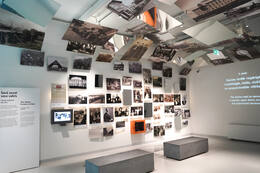On the occupation of Latvia
The existence of the independent state of Latvia in 1940 was interrupted by the occupation and annexation by the Soviet Union, or incorporation into the Union of Soviet Socialist Republics (USSR).
"June 17, 1940 arrived. A lady came into the bookstore and said that there was a Russian tank in the station area. I went to see. There was a Russian tank, a tanker was walking inside the tank, some people were standing around, nothing happened. there is some big change.
Late in the afternoon I went there again - to the station square. The goods station had, on the one hand, one-storey buildings with shops, rather chic shops, and there were such large glass windows. I saw several boys throwing stones at these windows, and one cried out to me - the sixth!
"There were rumors that something was happening around where the Metropole Hotel was, two protesters were shot dead, I once knew their names. army, but at the Esplanade ... The situation was tense, there were also arrests. Guards from the countryside were mobilized. "
"When did the envoys in London and Washington start protesting? Neither on June 17 nor on June 21. At first it seemed - what General Dambitis told me - that there would be an independent Latvia, friendship with the Soviet Union without Ulmanis, and everything."
"How cunningly it was played out - there are no communists in the first governments in all three republics. Then the local communists start to appear, then the Latvians from Russia, who were sent as deputy ministers, start to appear.
You know, in the early days, when someone shouted, "Long live Soviet Latvia!", The Communists called him - it was forbidden. The elections took place quickly, and from the time of Ulmanis, there was a box in your passport whether you took part in the elections - I know a lot of people went because they were afraid - if they can't go to trouble, no matter what the outcome. Ninety-seven percent is funny. ”
The memories were published in 2011 in Atis Klimovičs' book "Personal Latvia".
Related timeline
Related topics
Related objects
Museum of the Occupation of Latvia
The museum exhibits the history of Latvia from 1940 to 1991, under the occupation of Nazi Germany and the Soviet Union. ‘House of the Future’ is a reconstruction and expansion project of the Occupation Museum designed by the well-known American Latvian architect Gunārs Birkerts as well as the new exhibit of the museum. The exhibit ‘History of Cheka in Latvia’ was created by the Occupation Museum and it is located in the ‘Corner House’, which is the former USSR State Security Committee (KGB) building. Latvian Occupation Museum was founded in 1993. It tells the long-hidden story of the fate of the Latvian state, nation and land under the occupation of two foreign totalitarian powers from 1940 to 1991. At the end of 2020 the museum had more than 70,000 different historical items (documents, photographs, written, oral and material evidence, objects and memorabilia). Museum specialists have recorded more than 2,400 video testimonials, making it one of the largest collections on occupation in Europe. The events that unfolded in Latvia, Lithuania and Estonia clearly show us what the nations had to endure under the two totalitarian regimes.







